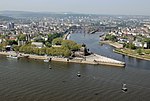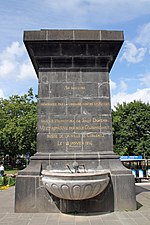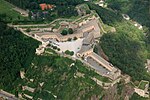Moselle

The Moselle ( moh-ZEL, French: [mɔzɛl] (listen); German: Mosel [ˈmoːzl̩] (listen); Luxembourgish: Musel Luxembourgish pronunciation: [ˈmuzəl]) is a river that rises in the Vosges mountains and flows through north-eastern France and Luxembourg to western Germany. It is a left bank tributary of the Rhine, which it joins at Koblenz. A small part of Belgium is in its basin as it includes the Sauer and the Our. Its lower course "twists and turns its way between Trier and Koblenz along one of Germany's most beautiful river valleys." In this section the land to the north is the Eifel which stretches into Belgium; to the south lies the Hunsrück. The river flows through a region that was cultivated by the Romans. Today, its hillsides are covered by terraced vineyards where "some of the best Rieslings grow". Many castle ruins sit on the hilltops above wine villages and towns along the slopes. Traben-Trarbach with its art nouveau architecture and Bernkastel-Kues with its traditional market square are two of the many tourist attractions on the Moselle river.
Excerpt from the Wikipedia article Moselle (License: CC BY-SA 3.0, Authors, Images).Moselle
Schartwiesenweg, Koblenz Lützel
Geographical coordinates (GPS) Address Phone number Website Nearby Places Show on map
Geographical coordinates (GPS)
| Latitude | Longitude |
|---|---|
| N 50.366111111111 ° | E 7.6069444444444 ° |
Address
Campingplatz Rhein-Mosel
Schartwiesenweg 6
56070 Koblenz, Lützel
Rhineland-Palatinate, Germany
Open on Google Maps











